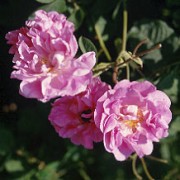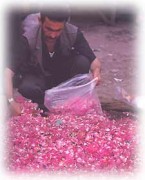|
The beautiful Damascus rose
 Throughout the Middle Eastern world the rose has always been regarded as the most perfect of all
flowers. In various stylized forms it is one of the principal elements in Muslim and Christian decoration and
design, the emblem of perfection and faithfulness. Throughout the Middle Eastern world the rose has always been regarded as the most perfect of all
flowers. In various stylized forms it is one of the principal elements in Muslim and Christian decoration and
design, the emblem of perfection and faithfulness.
The early sacred books of the Persians state that the rose was first cultivated by an
angel. One of the most beautiful popular roses is the Rose of Damascus or Damask Rose as it is known in
Europe. It is double-flowered with highly-scented petals and was cultivated by the ancient Syrians in a deliberate attempt to increase the number of its
flowers, the frequency of its flowering and its perfume. They finally achieved a magnificently fragrant rose with seven and sometimes nine
flowers, which under ideal environment, could flower several times a
year.
The Syrians have always been great rose enthusiasts, and the ancient name of their
country, Surirston, is said to mean "the land of the roses." Baskets of rose petals are still sold in the streets of Damascus and every Syrian family tries to grow at least one
rose, often in an old tin can.
The Damask rose has a very long history. It was admired in the Hanging Gardens of
Babylon. It was cultivated by the ancient Egyptians for exportation to Rome during the
winter. The pleasure-loving Roman market required vast quantities of roses and a rose grower could hardly hope to find a better customer
than, for instance Smyrndiride, the most wealthy and voluptuous of the Roman
Sybarites, who could not sleep if a single one of the rose petals with which his bed was
spread, happened to be curled.
At one stage in Arab history, the Abbasid Caliphs monopolized the cultivation of the Damask rose for their own enjoyment
because, as Caliph Mutawakkil (847- 61) said, "I am the King of Sultans and the rose is the king of the
sweet-scented flowers; each of us therefore is worthy of the other." But the Abbasid Caliphate fell and the Damask rose returned to its role as a popular
rose.
It was taken to Spain by the Moors, where it was greatly admired. In France a Rose herbal garden was begun in the town of
Provins, near Paris, from specimens of a related rose a Crusading French King had thoughtfully brought
home.
Damask roses were introduced into England during the reign of Henry VIII and were frequently displayed and scattered at weddings and
festivals. They have been used in wars as well. It is said that when the Muslim leader Saladin captured Jerusalem in 1187, he brought with him a retinue of 500 camels laden with rose water made from Damascus roses in order to purify the city before his
entry.
 Fragrance was very important in the culture of the Middle
East. Early Arab mosques were constructed with mortar mixed with musk so that the mosque was pervaded with scent during the hottest parts of the
day. The Damask rose was valued not only for the perfume of its blooms but also for its use in the manufacture of rose
water, a liquid which was obtained by distillation from the petals. Fragrance was very important in the culture of the Middle
East. Early Arab mosques were constructed with mortar mixed with musk so that the mosque was pervaded with scent during the hottest parts of the
day. The Damask rose was valued not only for the perfume of its blooms but also for its use in the manufacture of rose
water, a liquid which was obtained by distillation from the petals.
An Arabian doctor, Avicenna, is credited with the discovery of the process for extracting rose water from rose petals in the early 11th
century. Damask roses with their many flowers and ability to flower several times a year were ideal sources of rose
water, for more than six pounds of rose petals are needed to make one gallon of rose
water.
In the past rose water was used abundantly in perfumery and cookery, as a flavoring for
beverages, candies and confections. "The distilled water of roses is good for the strengthening of the spirits and likewise for all things that require a gentle
cooking," one famous medieval cook remarked. Western cookery today does not make much use of rose water but Mediterranean cuisine still favors
it, especially in such delicacies as rose petal jam.
|
